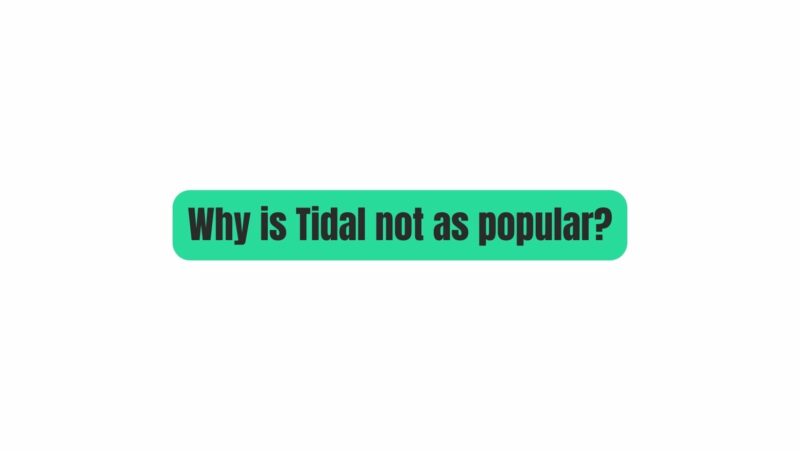In a crowded landscape of music streaming services, Tidal has carved a unique niche for itself as a platform dedicated to high-quality audio and artist-driven initiatives. Despite its lofty ambitions and notable features, Tidal has not achieved the same level of popularity as some of its competitors. In this article, we will examine the key factors contributing to Tidal’s relatively lower popularity in the streaming market.
1. Late Entry into the Streaming Market
One of the primary reasons behind Tidal’s limited popularity is its relatively late entry into the streaming market. When Tidal was launched in October 2014, competitors like Spotify and Apple Music had already established significant user bases. This late entry made it challenging for Tidal to gain a foothold and compete with established giants.
2. Initial Controversy and Celebrity Image
Tidal’s launch garnered attention not only for its high-quality audio promises but also for its star-studded ownership, including Jay-Z, Beyoncé, Madonna, and other high-profile artists. While this celebrity involvement generated significant buzz, it also created a perception that Tidal was a service primarily for artists and celebrities, which may have alienated some potential subscribers.
Additionally, Tidal’s initial announcement focused heavily on its exclusivity deals, which made certain albums available only on Tidal for a limited time. While exclusives can be a powerful marketing tool, they can also frustrate consumers who prefer access to their favorite music across multiple platforms.
3. Premium Pricing
Tidal positioned itself as a premium streaming service from the beginning, offering lossless audio and high-resolution audio options. While this appealed to audiophiles, the premium pricing structure made it less competitive in the mainstream market, where many consumers prioritize affordability.
The cost of Tidal’s HiFi and Masters subscriptions is notably higher than the standard tiers of its competitors. This pricing may deter budget-conscious consumers from subscribing to Tidal, especially when other platforms offer competitive features at lower price points.
4. Competition from Industry Giants
Tidal faced fierce competition from industry giants like Spotify, Apple Music, and Amazon Music, which had massive user bases and substantial marketing budgets. These platforms could afford to invest heavily in user acquisition, content acquisition, and marketing, making it challenging for Tidal to compete on equal footing.
Spotify, in particular, dominated the streaming landscape with its freemium model, offering both free and premium subscription options. This model allowed Spotify to attract a broad user base and gradually convert free users into paying subscribers, further intensifying the competition.
5. Limited Global Availability
In its early years, Tidal had a more limited global availability compared to its competitors. While Spotify and Apple Music were rapidly expanding to new countries, Tidal’s availability was concentrated in select regions. This geographical limitation restricted its potential user base and hindered its ability to compete on a global scale.
6. Marketing and Branding Challenges
Tidal faced challenges in effectively communicating its value proposition to consumers. While it emphasized high-quality audio and artist-friendly initiatives, this message did not always resonate with the broader music-loving audience. Competitors like Spotify and Apple Music focused on offering extensive music libraries and personalized playlists, which had broader appeal.
Moreover, Tidal’s branding as a platform “for artists by artists” may have alienated some listeners who perceived it as catering more to the interests of celebrities and musicians than to the average music enthusiast.
7. Evolving Music Consumption Habits
The music streaming landscape has evolved significantly since Tidal’s launch. While high-quality audio remains important to some audiophiles, the majority of music listeners have become accustomed to the convenience of on-demand streaming and are less focused on audio fidelity. This shift in consumer preferences may have worked against Tidal’s emphasis on high-resolution audio.
8. Exclusive Content Challenges
Tidal initially relied heavily on exclusive content deals with artists, aiming to differentiate itself from competitors. While exclusives can generate short-term buzz, they can also create frustration among consumers who prefer to access their favorite music on their preferred platforms. Additionally, exclusive content deals are expensive, and not all of them guaranteed long-term subscriber retention.
9. Change in Ownership and Strategy
Tidal experienced changes in ownership and strategy over the years. In 2015, Tidal was acquired by a consortium led by Jay-Z. Subsequent ownership changes and shifts in the company’s strategic direction may have contributed to a lack of consistency in messaging and branding.
10. Narrower Music Library
While Tidal boasts an extensive catalog of over 80 million tracks, it may not offer as many non-music audio options or podcasts as some competitors. This narrower focus could limit its appeal to users looking for a one-stop platform for all their audio content needs.
Conclusion
Tidal’s limited popularity in the streaming market can be attributed to a combination of factors, including its late entry into the market, premium pricing, competition from industry giants, initial controversies, marketing challenges, and evolving consumer preferences. Despite these challenges, Tidal has maintained its commitment to high-quality audio and artist-friendly initiatives, making it a unique and valuable platform for audiophiles and music enthusiasts who prioritize audio fidelity and artist support. Whether Tidal can continue to grow its user base and broaden its appeal in an ever-evolving industry remains a question worth exploring.


